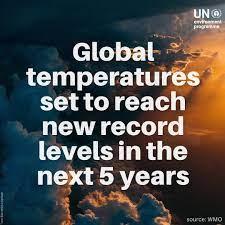
https://public.wmo.int/en/media/press-release/global-temperatures-set-re...
There is a 66% likelihood that the annual average near-surface global temperature between 2023 and 2027 will be more than 1.5°C above pre-industrial levels for at least one year. There is a 98% likelihood that at least one of the next five years, and the five-year period as a whole, will be the warmest on record.
“This report does not mean that we will permanently exceed the 1.5°C level specified in the Paris Agreement which refers to long-term warming over many years. However, WMO is sounding the alarm that we will breach the 1.5°C level on a temporary basis with increasing frequency,” said WMO Secretary-General Prof. Petteri Taalas.
“A warming El Niño is expected to develop in the coming months and this will combine with human-induced climate change to push global temperatures into uncharted territory,” he said. “This will have far-reaching repercussions for health, food security, water management and the environment. We need to be prepared,” said Prof. Taalas.
There is only a 32% chance that the five-year mean will exceed the 1.5°C threshold, according to the Global Annual to Decadal Climate Update produced by the United Kingdom’s Met Office, the WMO lead centre for such predictions.
The chance of temporarily exceeding 1.5°C has risen steadily since 2015, when it was close to zero. For the years between 2017 and 2021, there was a 10% chance of exceedance.
“Global mean temperatures are predicted to continue increasing, moving us away further and further away from the climate we are used to,” said Dr Leon Hermanson, a Met Office expert scientist who led the report.
Key points
- The average global temperature in 2022 was about 1.15°C above the 1850-1900 average. The cooling influence of La Niña conditions over much of the past three years temporarily reined in the longer-term warming trend. But La Niña ended in March 2023 and an El Niño is forecast to develop in the coming months. Typically, El Niño increases global temperatures in the year after it develops – in this case this would be 2024.
- The annual mean global near-surface temperature for each year between 2023 and 2027 is predicted to be between 1.1°C and 1.8°C higher than the 1850-1900 average. This is used as a baseline because it was before the emission of greenhouse gases from human and industrial activities.
- There is a 98% chance of at least one in the next five years beating the temperature record set in 2016, when there was an exceptionally strong El Niño.
- The chance of the five-year mean for 2023-2027 being higher than the last five years is also 98%.
- Arctic warming is disproportionately high. Compared to the 1991-2020 average, the temperature anomaly is predicted to be more than three times as large as the global mean anomaly when averaged over the next five northern hemisphere extended winters.
- Predicted precipitation patterns for the May to September 2023-2027 average, compared to the 1991-2020 average, suggest increased rainfall in the Sahel, northern Europe, Alaska and northern Siberia, and reduced rainfall for this season over the Amazon and parts of Australia.
Paris Agreement
In addition to increasing global temperatures, human-induced greenhouse gases are leading to more ocean heating and acidification, sea ice and glacier melt, sea level rise and more extreme weather.
The Paris Agreement sets long-term goals to guide all nations to substantially reduce global greenhouse gas emissions to limit the global temperature increase in this century to 2 °C while pursuing efforts to limit the increase even further to 1.5 °C, to avoid or reduce adverse impacts and related losses and damages.
The Intergovernmental Panel on Climate Change says that climate-related risks for natural and human systems are higher for global warming of 1.5 °C than at present, but lower than at 2 °C.
The new report was released ahead of the World Meteorological Congress (22 May to 2 June) which will discuss how to strengthen weather and climate services to support climate change adaptation. Priorities for discussion at Congress include the ongoing Early Warnings for All initiative to protect people from increasingly extreme weather and a new Greenhouse Gas Monitoring Infrastructure to inform climate mitigation.

Notes For Editors:
The Global Annual to Decadal Update is one of a suite of WMO climate products, including the flagship State of the Global Climate, which seek to inform policy-makers. WMO will release its provisional statement on the State of the Global Climate in 2023 at the UN Climate Change Conference, COP28, in December.
The UK’s Met Office acts as the WMO Lead Centre for Annual to Decadal Climate Prediction. This year there are 145 ensemble members contributed by 11 different institutes to the predictions, which start at the end of 2022. Retrospective forecasts, or hindcasts, covering the period 1960-2018 are used to estimate forecast skill.
Confidence in forecasts of global mean temperature is high since hindcasts show very high skill in all measures.
The forecasts shown here are intended as guidance for Regional Climate Centres (RCCs), Regional Climate Outlook Forums (RCOFs) and National Meteorological and Hydrological Services (NMHSs). It does not constitute an official forecast for any region or nation, but RCCs, RCOFs and NMHSs are encouraged to appropriately interpret and develop value-added forecasts from this Climate Update.
The World Meteorological Organization is the United Nations System’s authoritative voice on Weather, Climate and Water










Add new comment